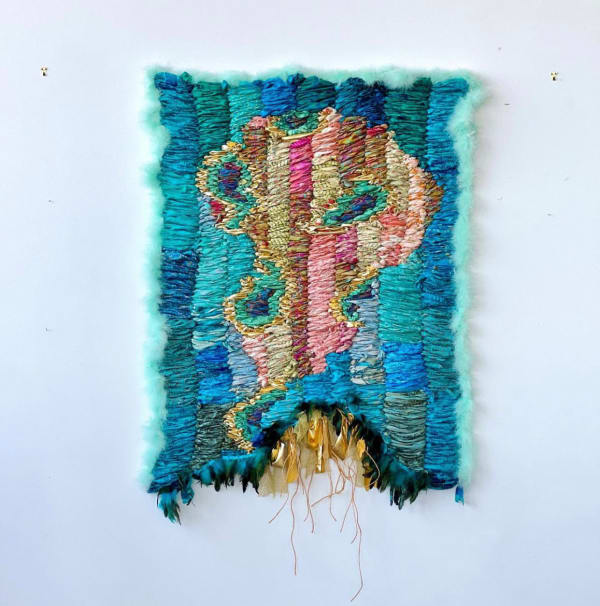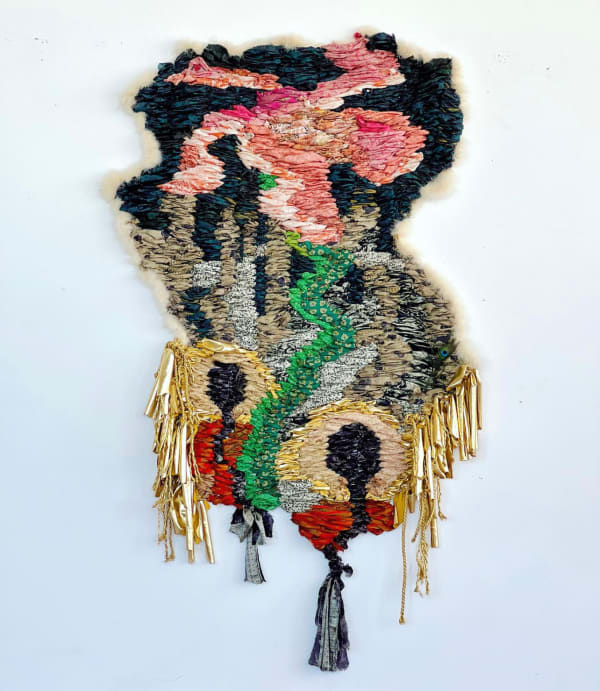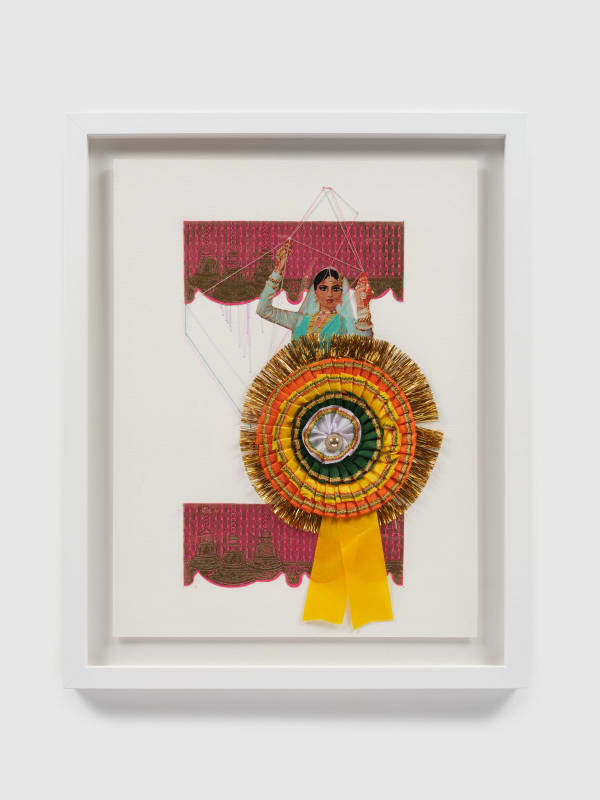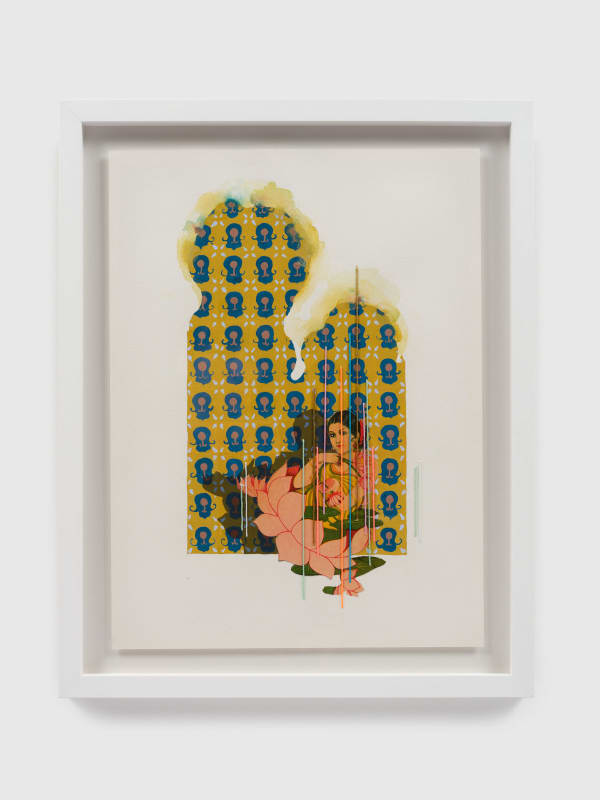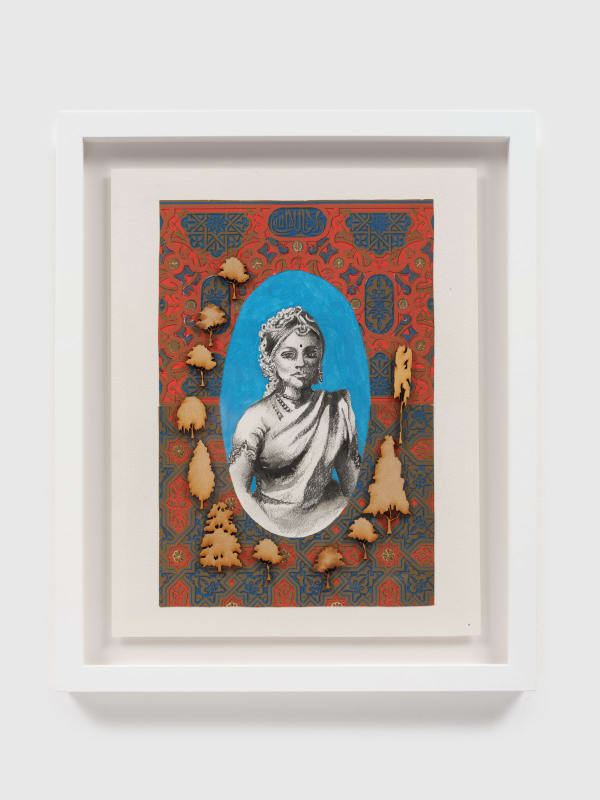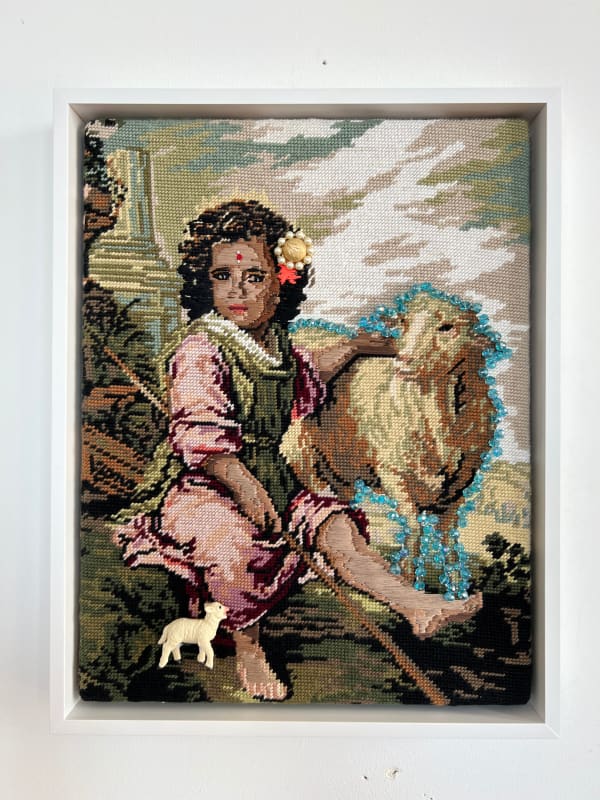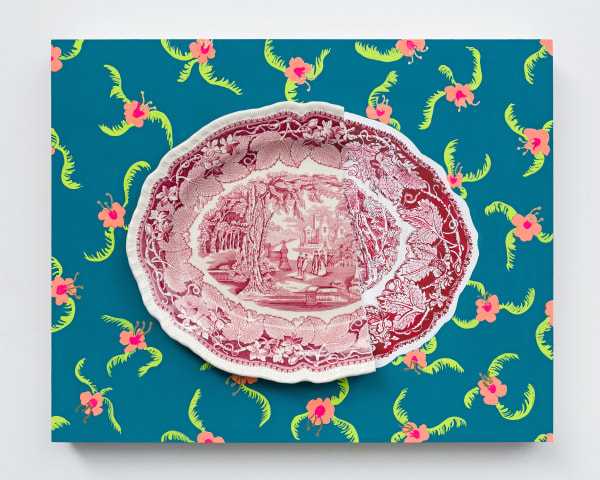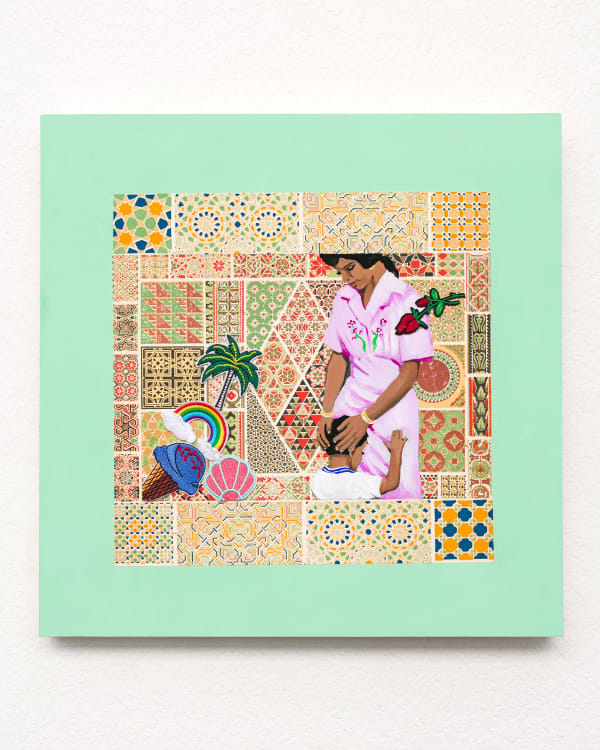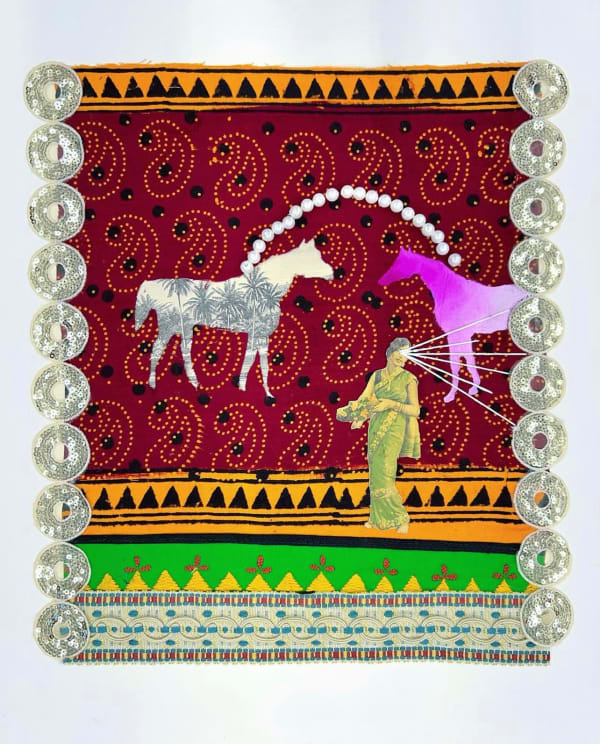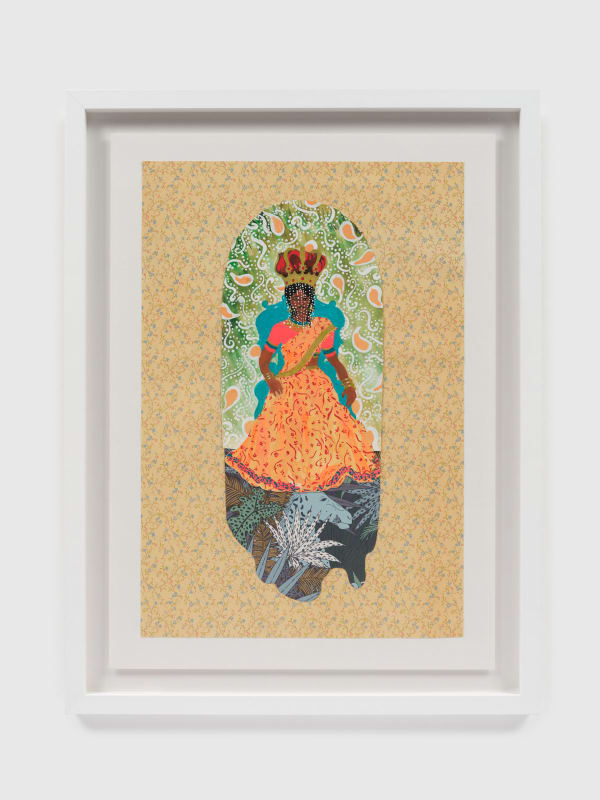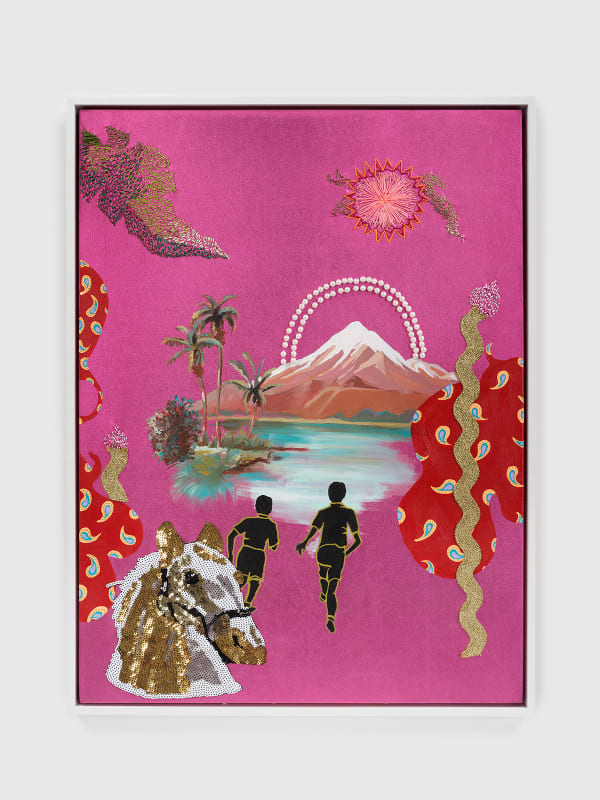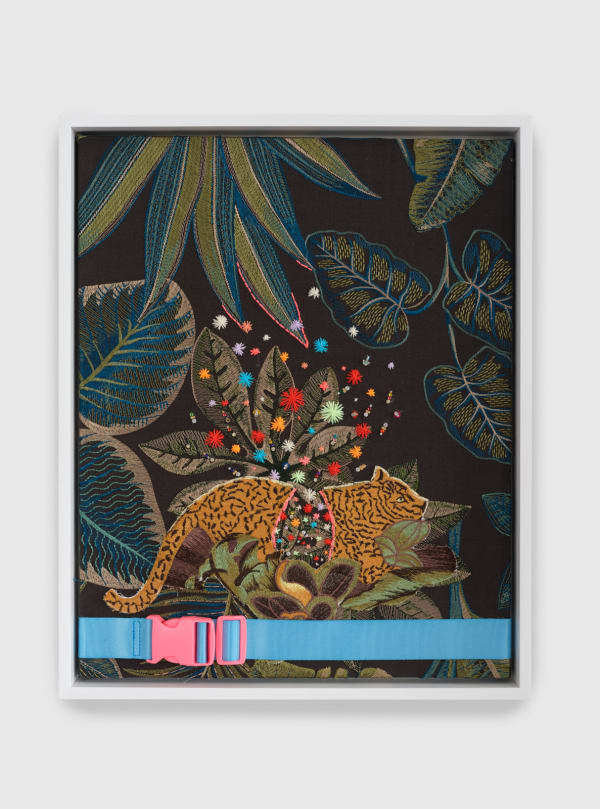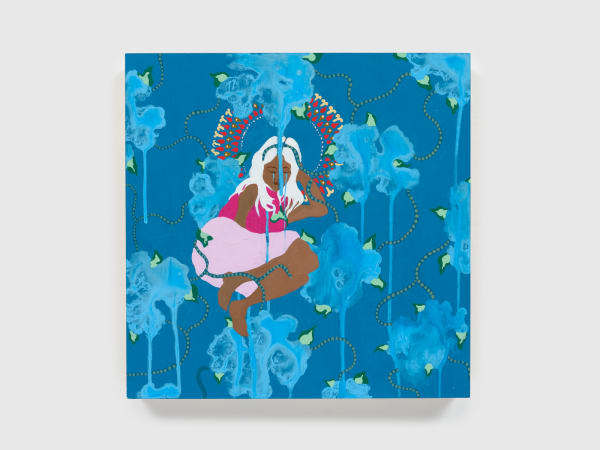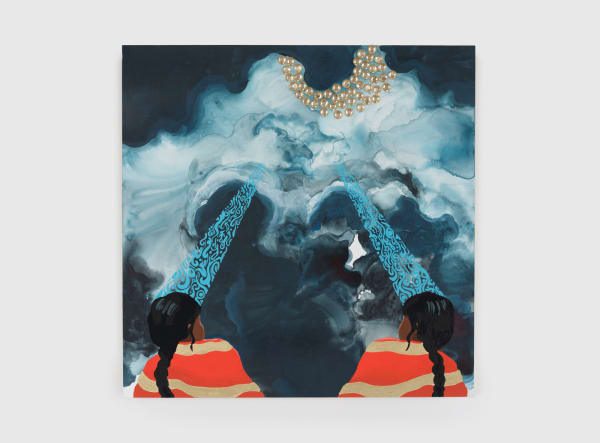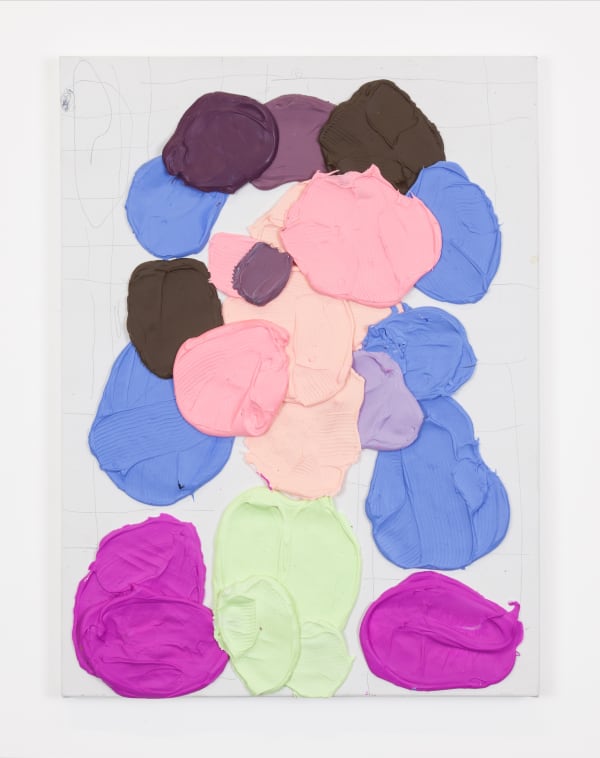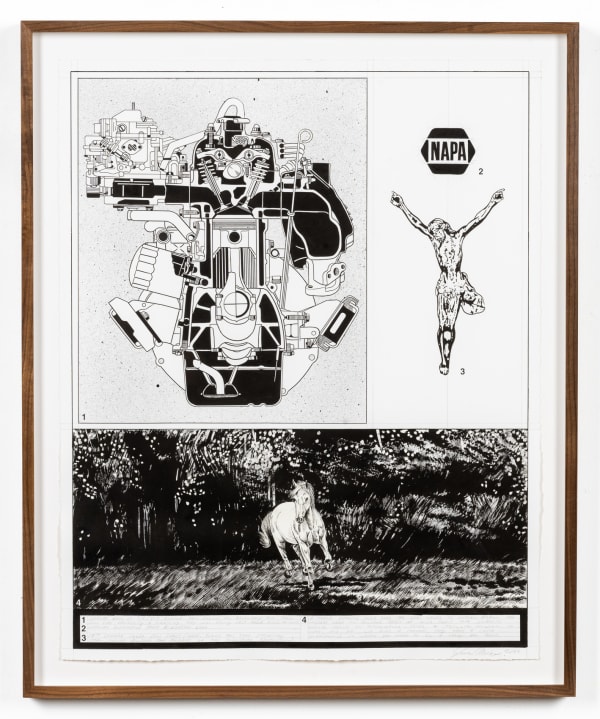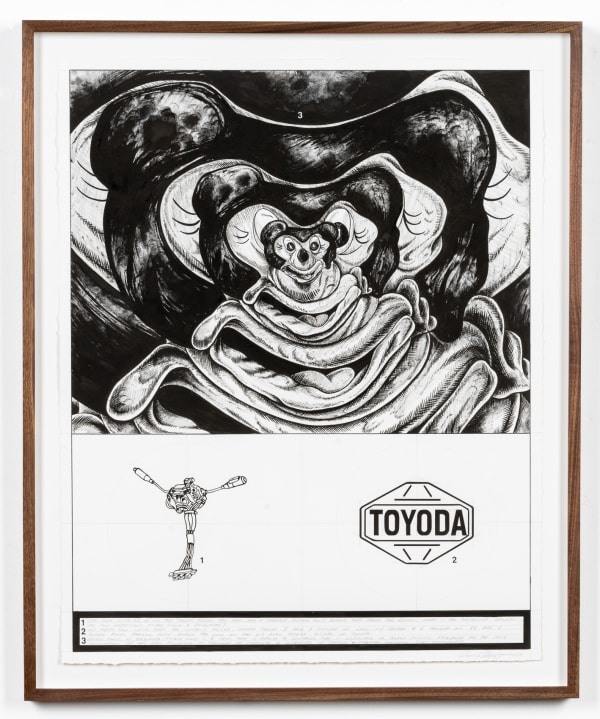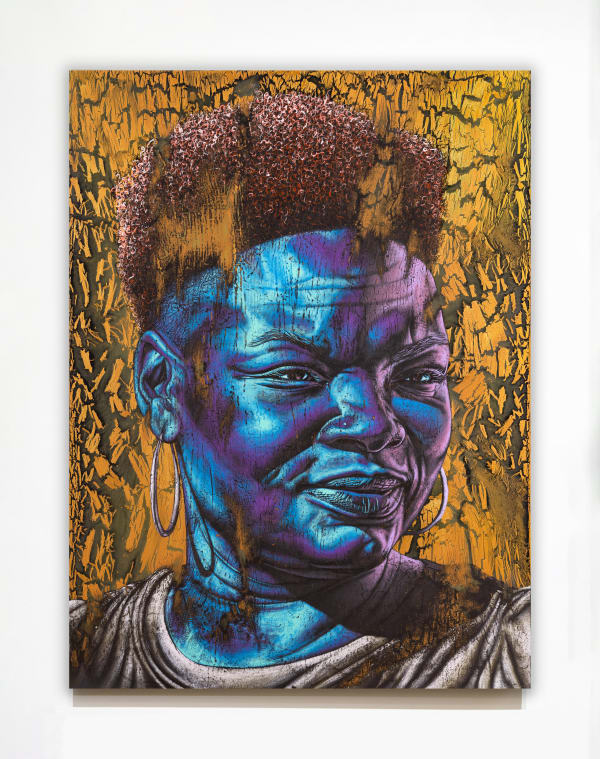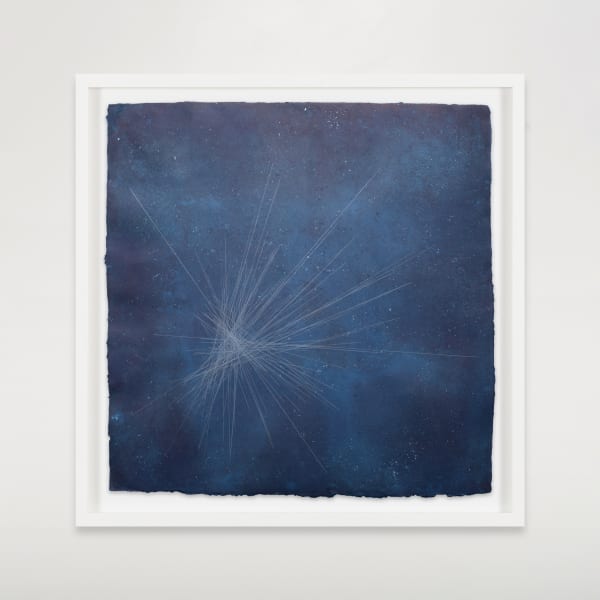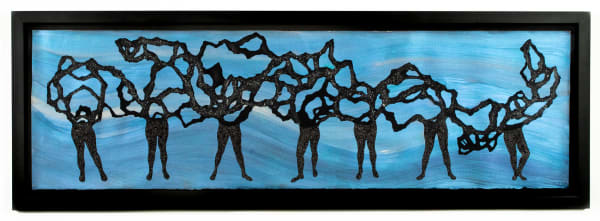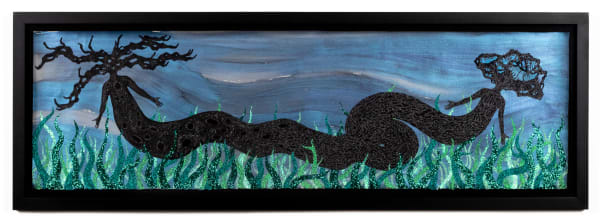-

-
Kavi Gupta welcomes the return of the Felix Art Fair, February 15-19, 2023 in Los Angeles.The elegant, boutique interior of the historic Hollywood Roosevelt Hotel offers us a unique opportunity to contextualize important works of contemporary art on a human scale, and within an intimate, personal environment. The relaxed, in depth interactions we’re able to enjoy with the public at Felix Fair are essential to our ongoing efforts to amplify voices of diverse and underrepresented artists to expand the canon of art history,For the 2023 Felix Art Fair, we will present a selection of two and three dimensional works from across our program, by artists who are key protagonists responding to critical contemporary concerns from the vanguard of intercultural, abstract, intertextual, figurative, interdisciplinary and conceptual art. -
Suchitra Mattai
-

-
Suchitra Mattai is a multi-disciplinary artist whose work tells visual stories that touch on her Indo-Caribbean lineage. Blending painting, sculpture and installation with methods suggestive of domestic labor which she learned from her grandmother, such as sewing, embroidery and crocheting, the work addresses such topics as the legacy of colonialism, and relationships between culture and gender roles.Mattai has lived in Guyana, Canada, the United States, India, and Europe. Her work addresses the disorientation of not really having a single home—a feeling that informs much of how Mattai thinks about identity. Found objects, as well as craft-based processes and materials, play an essential role in her practice, in part because of the potentialities that arise from materials with forgotten or erased histories. -
-
-
-
Mattai received an MFA in painting and drawing and an MA in South Asian art from the University of Pennsylvania, PA. Her work is in the collections of Crystal Bridges Museum of Art, Bentonville, AR, USA; Jorge Pérez; Olivia Walton; Denver Art Museum, Denver, CO, USA; Kiran Nader Museum of Art, Delhi, India; Tampa Museum of Art, Tampa, FL, USA; TIA Collection, Santa Fe, NM, USA; and Taylor Art Collection, Denver, CO, USA; among many others, and has been reviewed in publications such as Hyperallergic, The Boston Globe, Widewalls, and Wallpaper Magazine, among others. Current and forthcoming exhibitions include In the Adjacent Possible at John Michael Kohler Arts Center, Sheboygan, WI, USA; Form Forecast at MCA Chicago, IL, USA; The Depth of Identity: Art as Memory and Archive, curated by Rosie Gordon-Wallace and supported by the Green Foundation; Reorient at the Wing Luke Museum, Seattle, WA, USA; and Breathe into the Past: Cross Currents in the Caribbean, at the Colorado Fine Arts Center, Colorado College, Colorado Springs, CO. Recent exhibitions include Suchitra Mattai: Breathing Room, Boise Art Museum, Boise, ID, USA; State of the Art 2020, Crystal Bridges Museum/the Momentary, Bentonville, AR, USA; Sharjah Biennial 14, Sharjah, UAE; and Realms of Refuge, Kavi Gupta, Chicago, IL, USA; as well as exhibitions at the Center for Visual Arts, Metropolitan State University of Denver, CO, USA and the San Antonio Museum of Art, San Antonio, TX, USA. -
Allana Clarke
-

-
In this series of four photographs, Allana Clarke turns her gaze onto her own body as a means to interrogate her self perception in the context of social and cultural systems that attempt to mandate how she, as a Black woman, is valued by others. Clarke seeks out materials, processes and concepts that empower her to examine the shifting social and political hierarchies that keep Black bodies marginalized.These photographs mobilize the critical, selective eye of the camera to offer only glimpses of her body, indicative of a feeling of negation brought about by always seeing oneself in a fragmented way through the eyes of others in a commodified culture. Says Clarke, "The images oscillate between conceptions of desirability, and a presence intertwined with shame, violence and generational trauma, but moving through to a space governed by Black feminist futurity, that which is not yet actualized but must be.” -
-
Clarke earned her BFA in photography from New Jersey City University in 2011 and an MFA in Interdisciplinary Practice from MICA’s Mount Royal School of Art in 2014. She has been an artist in residence at the Skowhegan School of Painting & Sculpture, Vermont Studio Center, Lighthouse Works, and Yaddo, and has received several grants, including the Toby Devan Lewis Fellowship, Franklin Furnace Fund, and a Puffin Foundation Grant. Her work has been screened and performed at Gibney Dance in New York, Invisible-Exports in New York, New School’s Glass Box Theater in New York, FRAC in Nantes, France, and SAVVY Contemporary in Berlin, and was featured in the Bauhaus Centennial edition Bauhaus Now: Is Modernity an Attitude. She recently completed a 2020-21 NXTHVN fellowship and is an assistant professor at Wayne State University in Detroit. Clarke’s work was recently included in the group exhibition Realms of Refuge at Kavi Gupta | Elizabeth St. A solo project with the gallery is forthcoming in 2023.
-
Esmaa Mohamoud
-

-
African-Canadian artist Esmaa Mohamoud is a multi-disciplinary conceptual artist who describes her studio practice as an examination of “the monolithic versus the multitude.” Her work is a visually stunning and profound examination of the gap between contemporary culture's oversimplification and diminishment of Black people, compared to the complexity, richness, and diversity of their actual lived experiences.
Mohamoud’s critically acclaimed solo exhibition Esmaa Mohamoud: To Play in the Face of Certain Defeat, which toured the National Galleries of Canada, looks specifically at how the Black body is reduced within the vernacular of athleticism. Sculptures such as Glorious Bones critique depictions of the Black body as being disposable, while the photographic series One of the Boys examines the vulnerability of Black masculinity within the guise of professional sports.
Mohamoud was born and raised in the small suburban town of London, Ontario. Prized by marketers as so quintessentially representative of the Canadian population that it is a standard testing ground for consumer products, such as new potato chip flavors, London has also long been home to a majority white population. Mohamoud recalls frequently being the only Black person in academic and social settings, and most of her early encounters with representations of Blackness came from American media, which tended to present Black culture in superficial and monolithic terms. -

Esmaa Mohamoud
One of The Boys (White), 2019Archival pigment print
61 x 41 x 2 in
154.9 x 104.1 x 5.1 cm
Edition 4 of 5 plus 1 artist's proof -
Mohamoud is a 2021 Artist-in-Residence in Kehinde Wiley’s renowned Black Rock Senegal residency program in Dakar, Senegal. Her critically acclaimed solo exhibition To Play in the Face of Certain Defeat (originated at Museum London in Ontario) is currently on view at the Art Gallery of Hamilton (Ontario), and will travel in 2022 to the Art Gallery of Ottawa and the Art Gallery of Winnipeg, concluding at the Art Gallery of Alberta in 2023. In 2022, Mohamoud’s work will be included in the exhibition Garmenting: Costume and Contemporary Art, Museum of Arts and Design, New York, NY, USA. Her work has previously been exhibited at the Royal Ontario Museum; Museum of Fine Arts Montreal; and Weatherspoon Art Museum, UNCG, Greensboro, NC, USA, among others. Works by Mohamoud are in the permanent collections of the National Gallery of Canada; Art Gallery of Ontario; Weatherspoon Museum; Institute for the Humanities, University of Michigan; Museum London; and University of Victoria Legacy Art Galleries, among others. -
Kour Pour
-

-
Kour Pour is a British-Iranian-American artist whose visual language is informed by longstanding, global traditions of intercultural exchange. By intersecting a wide range of material and aesthetic conventions that are connected to various geographic, cultural, and national heritages, Pour allows for a remapping of the standard understanding of “Eastern/Western” cultural exchange.Pour was born in Exeter, England. His father owned a small carpet shop, and Pour would spend time there as a child. He also often traveled to Los Angeles to visit family on his father’s side, and he ultimately attended Otis College of Art and Design (BFA, 2010). In Los Angeles, he was exposed to hip-hop and became interested in the idea of sampling as it is practiced in music production, and how he might apply a similar practice in his artwork.Pour’s works encompass diverse subject matter and culturally specific references, ranging from Persian carpets to ukiyo-e prints, and Western abstraction to Eastern landscape painting. These references are used as starting points for his paintings, in which a source image is often cropped, abstracted, or adjusted in palette to create vivid, intricate, and layered painting surfaces. -

Kour Pour
A Warm Home on a Cold Night, 2023Acrylic on canvas over panel
9 x 7 in
22.9 x 17.8 cm -
-
A solo exhibition of Pour’s work is forthcoming at the Tehran Museum of Contemporary Art in Tehran, Iran. Other recent major exhibitions include A Boundless Drop to a Boundless Ocean, Orlando Museum of Art, Orlando, FL, USA; Kour Pour: Familiar Spirits, Kavi Gupta, Chicago, IL, USA; Returnee, The Club, Tokyo, Japan; Manzareh/Keshiki/Landscape, Ever Gold [Projects], San Francisco, CA, USA; Polypainting, Pearl Lam Galleries, Hong Kong, and GNYP Gallery, Berlin; Gold Standard: Ten Year Anniversary Exhibition at Ever Gold [Projects]; Decoration Never Dies, Anyway, Tokyo Metropolitan Teien Museum, Tokyo, Japan; and Labyrinth(s), Pearl Lam Galleries, Hong Kong. -
José Lerma
-

-
José Lerma’s practice is formally rooted in an investigation of painting in the expanded field. His exhibitions often include elaborate installations that incorporate such everyday items as office materials, musical instruments, and home furnishings. Conceptually, Lerma attempts to collapse the historical with the autobiographical, making works that are part art history and part personal mythology. Several of Lerma’s recurring themes deal with the tension between the heroic and the pathetic, as well as the rise and fall of great figures. His research examines the vast network of sociological, political, and economic forces that have shaped, and continue to shape, contemporary culture. His subjects have included international figures, such as American politician John Kerry, economist Milton Friedman, and King Charles II of Spain; pop culture icons, such as Julio Iglesias; everyday bureaucrats, bankers, and administrators; personal relations, such as his mother and father; and iconic religious scenes, such as the Last Supper.Lerma portrays his subjects in ways that elevate the mundane and trivialize the grand. He connects influential figures from history through trivial absurdities, crafting a visual world that is both celebratory and absurd. Simultaneously rooted in classical European painting and lowbrow pop art, his works express the tragic comedy of global colonial and post-colonial cultural relations in eye-popping and instantly relatable ways. -
Lerma was born in Spain and grew up in Puerto Rico. He earned an MFA from the University of Wisconsin Madison and BA from Tulane University, and attended the CORE Residency Program, Museum of Fine Arts, Houston, TX, and Skowhegan School of Painting & Sculpture, ME. He lives and works in Chicago, IL, and San Juan, Puerto Rico. His work has been in solo exhibitions at the Kemper Museum of Art, Kansas City, MO; Museum of Contemporary Art, Chicago, IL; and Museo de Arte Contemporáneo de San Juan, Puerto Rico, among others; as well as in group exhibitions at the Milwaukee Art Museum, WI; Institute Valecia d’art Modern, Spain; Museo de Arte de Ponce, Puerto Rico; Centro Atlantico de Arte Moderno, Las Palmas de Gran Canaria, Spain; DESTE Foundation for Contemporary Art, Athens, Greece; Museo del Barrio, New York, NY; and Museum of Fine Arts Houston, TX, and others. His work has been written about extensively in the press, including in The New Yorker, The New York Times, and Artforum. -
Jaime Muñoz
-

-
Jaime Muñoz is a Pomona, California-based painter whose works emblamatize the abiding struggle between humans, technology, and labor. His glimmering, pictographic compositions convey a masterful blend of representational precision and allegorical motif, suggesting a charmed space where everyday life is nurtured by magic and myth.Among Muñoz’s recurring motifs are utility trucks, horses, and dimensional text—imagery drawn from Muñoz’s personal background. More than direct figurative references, these are symbols inviting viewers into a world of post-capitalist iconolatry informed by centuries of colonialism and commodification.“The truck becomes emblematic of the circumstances of dehumanization that the worker experiences in their struggle to survive,” says Muñoz. “It operates like an index of this moment in time within our modern life experience. I compare it to the invention of the wheel, or the discovery of the horse, and I think of the ways that this truck reflects the circumstances of industrialization. When I use this index in my work, I intend to visibilize these hidden experiences of the worker, as represented by the truck.” -
Muñoz earned his BA in Fine Art from the University of California Los Angeles (UCLA). Recent exhibitions include Beyond The Streets On Paper, Southampton Arts Center, Southampton, New York, USA; Evocations: Celebrating the Museum's Collection, Nerman Museum of Contemporary Art, Overland Park, Kansas, USA; 4 Threads, Riverside Art Museum, Riverside, California, USA; and How to Read El Pato Pascual: Disney’s Latin America and Latin America’s Disney, MAK Center for Art and Architecture, Los Angeles, CA. His work has also been featured in the LA Times, Hyperallergic, JUXTAPOZ, Artillery Magazine, and Pacific Standard Time, among others.
-
Alfred Conteh
-

-
Alfred Conteh is a leader on the vanguard of American portraiture. He uses his studio practice to explore his identity and personal history from a number of different perspectives. Born in Fort Valley, GA, and based in Atlanta, his mother is African American and his father is from Sierra Leone, West Africa. Conteh’s work concerns the ways African Americans are dealing with disparities that have been affecting their communities for generations, especially in the Southern United States.Conteh’s paintings utilize materiality to elucidate the ways in which America subjugates its Black citizens by neglecting the infrastructure of Black neighborhoods and systematically denying Black citizens access to all the rights and privileges afforded to the majoritarian culture.Conteh’s long running series of figurative paintings, titled Two Fronts, explores images of contemporary members of the African diaspora, placing the figures in what are often mundane environments. The subjects of these portraits are the Black people Conteh meets and interacts with around the city of Atlanta, where he lives and works. The surfaces of the paintings look weathered, rusted, and degraded thanks to Conteh’s deft use of materials such as battery acid, rust, soil, and melted plastic. The material presence of the paintings is a reflection of the lives of Conteh’s sitters, who, as Conteh points out, do not have access to the full vision of American-ness. -
-
Recent major exhibitions of Conteh's work include Alfred Conteh: The Sweet Spot, Clark Atlanta University Art Museum, Atlanta, GA; Men of Change: Power. Triumph. Truth., Smithsonian Institution Traveling Exhibition Service; Visions of a Cultural Commentator, curated by Madeline Beck, Cobb Marietta Museum of Art, Marietta, GA; Alfred Conteh, Selected Works, Harriet Tubman Museum, Macon, GA; and 5 Perspectives, Steffan Thomas Museum of Art, Madison, GA. Conteh's work is included in several major collections, including that of the The Legacy Museum, Montgomery, AL; the Lauren Rogers Museum of Art, Laurel, MS; Clark Atlanta University Art Museum, Atlanta, GA; and several others.
-
Miya Ando
-

-
Miya Ando is a multidisciplinary abstract artist whose works reference the ephemerality of nature and the transitory nature of existence.
Ando's images and forms reference such fleeting stuff as clouds, moonlight, tides, and the seasons. Her materials—such as steel, glass, and aluminum—convey a sense of durability and strength. Transformed by Ando, materials related to permanence become embodiments of impermanence.
"Making art is a function of thinking,” Ando says. “I endeavor to stay on a focused train of thought from one piece to the next, each completed work begets the next work. It’s a continuum of thought and the works are a residue of that thinking process."
Ando presents the titles of her works in Japanese and English. During her time living in Japan, she researched literary and historical texts, compiling poetic Japanese descriptions of natural phenomena. Present in the Japanese descriptions are nuanced layers of thought often lacking in the English translation. These bi-lingual titles convey the sense of duality Ando experiences living between two cultures. -
Ando’s work has been the subject of recent solo exhibitions at The Asia Society Museum, Houston; The Noguchi Museum, New York; Savannah College Of Art and Design Museum, Savannah; The Nassau County Museum, Roslyn Harbor; and The American University Museum, Washington DC. Her work has also been included in recent group exhibitions at The Crystal Bridges Museum of American Art, Bentonville; The Los Angeles County Museum of Art; The Haus Der Kunst, Munich; The Bronx Museum; and The Queens Museum of Art, NY. Ando’s work is included in the public collections of LACMA; The Nassau County Museum; The Corning Museum of Glass; The Detroit Institute of Arts; The Luft Museum; Scottsdale Museum of Contemporary Art; The Santa Barbara Museum of Art; The Museum of Art and History; among other public institutions as well as in numerous private collections. Ando has been the recipient of several grants and awards including the Pollock-Krasner Foundation Grant Award, and has produced numerous public commissions, most notably a thirty-foot-tall sculpture built from World Trade Center steel installed in Olympic Park in London to mark the ten-year anniversary of 9/11, for which she was nominated for a DARC Award in Best Light Art Installation. Ando was also commissioned to create artwork for the historic Philip Johnson Glass House, New Canaan, CT. The artist holds a bachelor’s degree in East Asian Studies from the University of California, Berkeley, studied East Asian Studies at Yale University and Stanford University, and apprenticed with a Master Metalsmith in Japan. -
Beverly Fishman
-

-
Beverly Fishman is a leading protagonist in the field of politically activated abstract art. An Anonymous Was A Woman Award Winner, John Simon Guggenheim Memorial Foundation Fellow, and National Endowment for the Arts Grantee, Fishman dedicates her studio practice to an aesthetic examination of people’s relationship with the business, politics and chemistry of healing.For decades, Fishman's research has focused on the visual vocabulary that pharmaceutical designers deploy in their calculated efforts to market antidepressants, anxiolytics, amphetamines, anti-inflammatories, beta blockers, opioids, and other chemicals to the masses. Morphed and elevated by Fishman in her studio, these medicinal motifs become the building blocks for ecstatic, abstract visual cocktails that open doors to the aesthetic sublime.Fishman’s luminescent, geometric relief paintings beguile the eyes. Along with their radiant material presence, their uncanny structures challenge viewers to look beyond the surface, to try to recall where it was that they have seen these curious shapes before. Epiphany is aided by the titles Fishman gives her paintings, which invoke a litany of ills, such as depression, high blood pressure, bipolar disorder, opioid addiction, insomnia, and ADHD—these are pharmaceutical forms, abstracted from the pills we ingest every day to balance our bodies and minds.
-
-
Recent major exhibitions of Fishman's work include FEELS LIKE LOVE, Kavi Gupta, Chicago, IL; Recovery, Eli and Edythe Broad Art Museum, East Lansing, MI, USA; I Dream of Sleep, Miles McEnery, New York, NY, USA; Future Perfect, Kavi Gupta, Chicago, IL, USA; Double Edged: Geometric Abstraction Then and Now, curated by Dr. Emily Stamey, Weatherspoon Art Museum, Greensboro, NC, USA; DOSE, curated by Nick Cave, CUE Art Foundation, New York, NY, USA; Pill Spill, Detroit Institute of Art, Detroit, MI, USA; and Beverly Fishman: In Sickness and in Health, Chrysler Museum of Art, Norfolk, VA, USA. Fishman has received numerous awards, including the 2018 Anonymous Was A Woman Award; the John Simon Guggenheim Memorial Foundation Fellowship; and the NEA Fellowship Grant. Work by Fishman is included in the collections of the MacArthur Foundation, the Detroit Institute of Arts, the Columbus Museum of Art, the Chrysler Museum of Art, and many others. Fishman served as the head of painting and as artist-in-residence at the Cranbrook Academy of Art for twenty-seven years. -
Alisa Sikelianos-Carter
-

-
Alisa Sikelianos-Carter is a mixed-media painter from upstate New York. Her work asserts that Black features are a manifestation of a sacred and divine technology that has served as a means of survival, both physically and metaphysically. She envisions a cosmically bountiful world that celebrates and pays homage to ancestral majesty, power, and aesthetics.Inspired by traditionally Black hairstyles, Sikelianos-Carter uses web and catalogue-sourced images to construct new archetypes. Through her exploration of opulent, luminescent materials she is creating a mythology that is centered on Black resistance and utilizes the body as a sight of alchemy and divinity.“I want to live in a world in which every micro-aggression, attack on humanity, and doubt of divinity aimed at Black people is destroyed by future-sent deities,” says Sikelianos-Carter. “These Godx are completely enveloped and adorned by magnificent cornrows, dreadlocks, and twists. The hairstyles act as armor and weapon, protecting and repelling wearers from white supremacy and misogyny. These are the beings I create. My wildest dreams realized; a marriage between the spectral beings we (as Black people) can and will transform into as a result of the culture we currently live in with the majesty, magic, and tradition of our ancestors.” -
-
Sikelianos-Carter earned her BA and MA in Painting and Drawing from SUNY Albany. She is a recent NXTHVN Fellow, and in 2021 was awarded the inaugural fellowship at Foreland, a six month studio residency in the Catskills conferred biennially on an outstanding artist of color. Recent exhibitions of her work include Realms of Refuge, Kavi Gupta, Chicago, IL; NXTHVN Fellows Group Show, New York, NY; Beasts Like Me: Feminism and Fantasy, Bronx Art Space, Bronx, NY; and Never Done: 100 Years of Women in Politics and Beyond, Tang Teaching Museum at Skidmore College, Saratoga Springs, NY. Sikelianos-Carter was featured in New American Paintings, No. 146, Northeast Issue, and received the Sustainable Arts Foundation Grant. She has been awarded residencies at the Millay Colony for the Arts, Austerlitz, NY; Vermont Studio Center, Johnson, VT; Wassaic Project, Wassaic, NY; Yaddo, Saratoga Springs, NY; and Fountainhead Residency, Miami, FL. -
Michi Meko
-

-
Michi Meko is a multidisciplinary artist whose rigorous studio practice is grounded in a material, metaphorical, and philosophical examination of what he calls “the African American experience of navigating public spaces, particularly in the American South, while remaining buoyant within them.”Incorporating romanticized found objects as well as the visual language of mapping, flags, and wayfinding into his work, Meko constructs transcendent aesthetic spaces into which the viewer’s psyche is free to wander.“These references signal the warning of a threat or the possibility of safe passage,” Meko says. “Working beyond the physical image of the body, objects of buoyancy and navigation become metaphors for selfhood, resilience, and the sanity required in the turbulent oceans of contemporary America.”
-

Michi Meko
A Fugitive GPS, 2022Acrylic, aerosol, oil pastel, gold leaf, aerosol hologram glitter, white colored pencil, india ink, gouache on canvas
72 x 48 in
182.9 x 121.9 cm -
Meko is the recipient of the Joan Mitchell Foundation Grant and the Atlanta Artadia Award, and was a finalist for the 2019 Hudgens Prize. Recent exhibitions of Meko's work include Dark was the Night, Cold was the Ground, Kavi Gupta. Chicago, IL; The Dirty South, Virginia Museum of Fine Art, Richmond, VA; Realms of Refuge, Kavi Gupta, Chicago, IL; Michi Meko: Black and Blur, Clark Atlanta University Art Museum, Atlanta GA; Michi Meko: It Doesn’t Prepare You for Arrival, Museum of Contemporary Art of Georgia (MOCA GA), Atlanta, GA; Michi Meko: Before We Blast off: The Journey of Divine Forces, Atlanta Contemporary Art Center, Atlanta, GA and Abstraction Today, MOCA GA, Atlanta, GA. His work is held in the collections of the High Museum of Art, Atlanta, GA; King & Spalding, Atlanta, GA; Scion (Toyota Motor Corporation), Los Angeles, CA; MetroPark USA Inc., Atlanta, GA; and CW Network, Atlanta, GA, among others. -
Nikko Washington
-

-
Nikko Washington is a multimedia artist from the Hyde Park neighborhood of Chicago. His work is rooted in portraiture, and frequently centers the artists, activists, and influencers who have made an impact on his community. A believer in the idea that if people don’t learn from their history they’ll repeat it, Washington makes work that archives and contextualizes the present moment through the lens of mythology and storytelling.The subject of fighting appears frequently in Washington’s work. A trained martial artist and boxer, he portrays legendary fighters like Muhammad Ali, Floyd Mayweather, and Mike Tyson as larger than life figures emulating the gladiators of the past. Boxing is also one lens through which Washington addresses ideas surrounding racial identity and equity. Referring to the 1910 title fight between Jack Johnson, who was Black, and the white fighter James J. Jeffries, a.k.a. The Great White Hope, Washington says, “With racial issues, American nature sort of has this caveat of both sides betting on each other to lose.”Washington’s studio practice is also deeply influenced by the fighting arts. He has used punching bags, boxing gloves, and riot shields as material elements in his work. His practice is also informed by the less obvious mental aspects of the fighting arts, such as precision and discipline. “The push and pull of the physical and the mental, grappling in the studio with my work—boxing gave me mind and body control that is similar to the mental head space of painting,” Washington says.
-

Nikko Washington
Jack II, 2021Oil and spray paint on canvas
40 x 30 x 2 in
101.6 x 76.2 x 5.1 cm -

Nikko Washington
Overrun, 2022Oil and acrylic on canvas
24 x 48 in
61 x 121.9 cm -
Washington earned his BFA at the Milwaukee Institute of Art & Design and the School of The Art Institute of Chicago. Recent exhibitions include, School Of The Art Institute of Chicago BFA Exhibition, Sullivan Gallery, Chicago, IL; Solo Exhibition, The Bad Sleep Well, Chicago, IL; Y:ou Gallery, Solo Exhibition, Chicago, IL; 53 Till Infinity, Logan Center Cafe, University of Chicago, Chicago, IL; Artist and Residency, Soho House Chicago, Chicago, IL; Group Exhibition, A Legacy On Our Own Terms Heaven Gallery, Chicago, IL; Group Exhibition, Something About Us, Anthony Gallery, Chicago, IL; Group Exhibition, Neighborhood Gallery, Innersect, Shanghai, CN; and Group Exhibitions, Skin and Masks, I-III, Kavi Gupta Gallery, Chicago, IL.
-
-

-
Jewel Ham (b. 1998, USA) is a multi-media visual artist whose work mobilizes the figure to narrate inangible emotional states. Working in a ranger of mediums including oils, acrylics and pastels, Ham constructs layered, painterly images that express both psychological energy and material weight. Ham describes her painting practice as being rooted in “shit talking and reparations.” Her use of the term reparations goes beyond financial aspects into issues like how Black people occupy physical and emotional space within society, and how they can investigate those questions within a space of real freedom.“Shit talking is important because Black people have been forced to be super creative about everything we do and say,” says Ham. “We have to use what we have. The way we do fashion, food, music. It’s something that only we can do, so we have to shit talk about it.” Ham uses humor to invite viewers into the space. Her intent is to make anyone feel welcome within her painted worlds, and to create a sense of real empathy between viewers and the figures in her paintings.At the same time, she imbues her paintings with a profound sense of attitude, populating the visual space with scenes expressive of expressing histories and feelings that are not intended to be accessible to every viewer. Whether its the figure’s gaze, or symbolic elements within the compositon, Ham is intentionally deploying aesthetic barriers within her painted spaces. Everyone is welcome to look, but not everyone is going to understand or have access to everything that’s going on. -

Jewel Ham
if it were a snake, 2022Oozing paint and gestural marks mirror the sense of passion and drama in the central figure’s face. Ham mobilizes portraiture to narrate intangible emotional states. Her images express both psychological energy and material weight. -
Ham earned her Bachelor of Fine Arts from Howard universtiy in Washington, DC. Her paintings were featured in New American Paintings No. 154, South Issue. She was the 2021 recipient of the South Arts State Fellowship - North Carolina. In 2020, she was commissioned to create the Black Lives Matter mural at Keith YMCA in Charlotte, NC.



